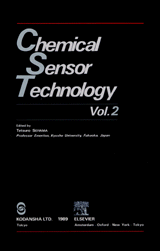Chemical Sensor Technology, Vol. 2
- タイトル読み
- 著者ほか
- 清山哲郎・編
- 著者ほか読み
- セイヤマテツロウ
- シリーズ:
- 英文書シリーズ

- 発行
- 1989
- サイズ
- B5変型
- ページ数
- 304
- ISBN
- 978-4-06-204558-2
- 定価
- 12,815円(税込)
- 在庫
- 在庫無し
内容紹介
<英文書>
ガスセンサ、バイオセンサ、イオンセンサなど化学センサの基礎、実用化、応用に関する最新の先導的研究を集録。国際的に精選された第一線の研究者が、新技術の展開のみならず研究思想や方法論にも言及。信頼性の高い情報を提供する最新のシリーズ第2巻。海外提携先:Elsevier B.V.
目次
Palladium Gate Hydrogen Sensors
1. Introduction
2. Devices
3. Summary of Experimental Results for Hydrogen
4. Model for the Hydrogen Sensitivity
5. Other Hydrogen-Containing Gases
6. Detection of Oxygen
7. Other Gate Metals
8. Concluding Remarks
Properties of Pd-Gate Heterostructure Diodes for Hydrogen Detection
1. Introduction
2. Device Configurations and Detection Mechanisms
3. I-V Characteristics of Pd-Gate MS, MIS, and MIM Heterostructure Diodes
4. Kinetic Response
5. Sensitivity
6. Effect of Temperature
7. Effect of Other Gases in the Ambient on Hydrogen Detection
8. Operating Bias Dependence of the Sensitivity
9. Summary
Fabrication of Integrated Thin Film Semiconductor Gas Sensors
1. Introduction
2. The Thin Sensitive Film
3. The Silicon Gas Sensor Structure
4. Experimental Results
Ozone Detection by In2O3 Thin Film Gas Sensor
1. Introduction
2. Semiconductor O3 Gas Sensor
3. In2O3 Thin Film Type O3 Gas Sensor
4. Summary
Stability of the Sensitivity of SnO2-Based Elements in the Field
1. Introduction
2. Principle and Structure of the Gas Leakage Detector
3. Working Conditions of SnO2 Sensor in the Field
4. "Hypersensitivity"
5. Cause of "Hypersensitivity"
6. Conclusions
Air/Fuel Ratio Sensors Using Perovskite-type Oxides
1. Introduction
2. General Principle
3. Stoichiometric A/F Sensor
4. Lean-burn Oxygen Sensor
5. Summary
Electropolymerized Films as Chemical Sensor Materials
1. Introduction
2. Electrochemical Polymerization
3. Permselectivity
4. Ion-Exchange Properties
5. Electron Mediation and Electrocatalysis
6. Ion-Selective Electrodes
7. Glucose Sensor
8. Gate Film of FETs
9. Usage of Doping and Undoping
10. Future Prospects
Design of Polymer Electrolytes-Based Humidity Sensors
1. Introduction
2. Sensors Utilizing Homopolymers
3. Sensors Utilizing Random Copolymers
4. Sensors Utilizing Crosslinked Polymers
5. Sensors Utilizing Graft Copolymers
6. Mechanism of Electrical Conduction in the Humidity Sensor Based on Polymer Electrolytes
7. Conclusion
Humidity Sensor Using TiO2-SnO2 Ceramics
1. Introduction
2. Ceramic Humidity Sensors
3. Thick Film Type TiO2-SnO2 Ceramic Humidity Sensor
4. Disk Type TiO2-SnO2 Ceramic Humidity Sensor
5. Some Remarks on TiO2-SnO2 Ceramic Humidity Sensors
6. Conclusions
Electrode Reactions in Potentiometric Gas Sensor
1. Introduction
2. Wagner's Description and Bulk Reactivity
3. Surface Reactivity
4. Descriptions Based on Conventional Electrochemistry
5. Catalytic Electrodes
Development of ISFET Using Glassy Solid Electrolytes
1. Introduction
2. Experimental
3. Results and Discussion
4. Conclusion
Integrated Multibiosensors Fabricated on SOS Chip
1. Introduction
2. ISFET Biosensor
3. Integrated Multibiosensor
4. Integrating Other Sensors on the SOS Chip
5. Application
6. Conclusion
Enzyme Embodies Electrode――A New Amperometric Biosensing Device
1. Introduction
2. Fabrication Technique of EEE
3. Batch Mode Operation of EEE Sensor
4. Flow Injection Analysis Mode Operation of EEE Sensor
5. Pulse Voltammetric Mode Operation EEE Sensor
6. Concluding Remarks
Optical Immunosensors
1. Introduction
2. Luminescent Immunosensors
3. Electrochemical Luminescence-Based Immunosensor for Homogeneous Immunoassay
The Molecular Recognitive Component of Chemical Sensor Selectivity
1. Introduction
2. The Conventional Approach to the Recognition Process
3. Information Theory and Recognition by Chemical and Biosensors
4. Bimolecular Interactions Studied by Molecular Graphics
5. Experimental Studies in Molecular Recognition
Use of Bacterial Magnetite for Biosensing
1. Introduction
2. Characterization of Bacterial Magnetite
3. Glucose Sensing by Glucose Oxidase Immobilized on Bacterial Magnetites
4. Squamous Cell Carcinoma (SCC) Sensing by Antibody Immobilized on Bacterial Magnetites
5. Mouse IgG Sensing by FITC-Conjugated Anti-Mouse IgG Immobilized on Bacterial Magnetites
6. Conclusion
Biosensing Using Calorimetric Devices
1. Introduction
2. Fundamentals of Calorimetric Biosensors
3. New Trends in Enzyme Thermistors
4. Concluding Remarks